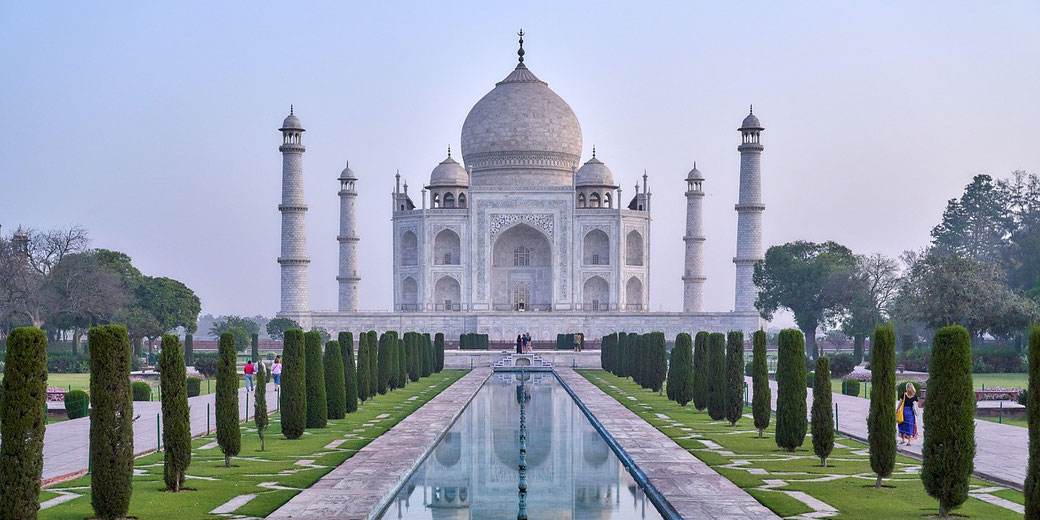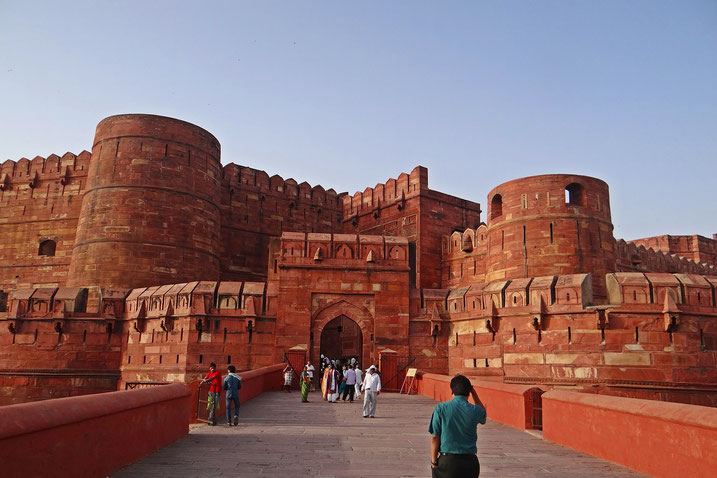The majestic Mughal Empire: The rise and fall of India's most powerful dynasty

The Mughal Empire was one of the most powerful empires in the world for centuries. It was founded in 1526 by Babur and, at its peak, spanned from the Deccan in the south to the Himalayas in the north, and from the eastern parts of present-day India to the western regions of Afghanistan.
The Mughals were Muslims, and their empire was marked by a blend of Islamic and Indian cultures. Under Akbar, the Mughal Empire reached its height of power and prosperity.
The Mughals were eventually replaced by the British Empire in the mid-19th century.
The origins of the Mughal Empire
The Mughal Empire was founded in 1526 by the king Babur, who had arrived in the area in response to a request for assistance from a local ruler named Daulat Khan Lodi.
After his early failures in Central Asia, Babur had long been focused on northern India, drawn by its wealth and the political instability of the Delhi Sultanate.
As a descendant of Timur and Genghis Khan, he believed that his destiny lay in ruling vast territories, but setbacks in Samarkand and elsewhere had forced him to establish his base in Kabul by 1504.
This position gave him the advantage of proximity, allowing him to observe the situation in India, where the Delhi Sultanate was weakening under Sultan Ibrahim Lodi.
In the early 16th century, Ibrahim Lodi's rule faced growing dissent from within his own ranks.
Daulat Khan Lodi, governor of the Punjab, was one of the most prominent figures who had become disillusioned with Ibrahim’s increasingly autocratic methods.
In 1524, he reached out to Babur, hoping to use his military strength to overthrow Ibrahim and restore local control in the Punjab.
However, Babur was more interested in the riches and strategic opportunities of northern India, so he seized the chance to intervene.
When Babur crossed the Khyber Pass, it resulted in the First Battle of Panipat on April 21, 1526. Babur’s army, which was equipped with advanced artillery, decisively defeated Ibrahim Lodi’s forces, which were larger but poorly coordinated.
Consequently, Babur established himself as the ruler of northern India.
Although Daulat Khan Lodi had hoped to benefit from Babur’s success, Babur quickly made it clear that he intended to rule independently.
He began solidifying control over the northern regions and laying the foundations for what would become one of the most powerful empires in the Indian subcontinent.
Reign of Babur
Babur's reign was filled with military expansion and the consolidation of Mughal power in India.
He continued to push eastward, defeating the Bengal Sultanate and expanding Mughal control over much of northern India.
Babur also initiated diplomatic relations with the Safavid and Ottoman Empires.
Babur was a Muslim, but he was tolerant of other religions and did not force conversion on his Hindu subjects.
He also patronised the arts, commissioning the construction of gardens and mosques.
In 1530, Babur died and was succeeded by his son, Humayun. Unlike his father, Humayun's rule was defined by military setbacks and the loss of much of the Mughal Empire.
He was forced to flee India after being defeated by Sher Shah Suri in 1540.
During his exile from 1540 to 1555, Humayun found refuge in the Persian court, where he forged an alliance that proved essential in his eventual reconquest of the Mughal throne.
Then, Humayun regained control of the empire after Sher Shah's death in 1545, but he lost it again just five years later.
In 1556, Humayun died after falling down a flight of stairs. He was succeeded by his young son Akbar, who was around 16 years old at the time.
Imperial successions
Although each Mughal ruler was usually the son of his predecessor, the line of succession was not always smooth.
Because the throne was elective, no individual or family had an absolute claim to it; rather, each son got an equal piece of his father's property, and all males in a royal court were entitled to succeed to the crown, leading to a lengthy, and contentious, system.
There were often bitter disputes between brothers, and sometimes between fathers and sons.
These disputes often led to civil war and bloodshed. Therefore, the rule of succession is best explained by the Persian phrase Takht, ya takhta, which meant "either the throne or a funeral".
Akbar the Great
The Mughal Empire reached its height under Akbar. During his reign, which lasted from 1556 to 1605, he expanded the empire further, conquering parts of Afghanistan and Central Asia.
Akbar was an able administrator and a great military leader. To strengthen his empire, Akbar introduced the mansabdari system in the 1560s, a sophisticated administrative framework that ranked officials and allowed him to centralize power efficiently.
Akbar also reformed the administration of justice and introduced new religious policies that helped create a more tolerant society.
He abolished the tax on non-Muslims and encouraged interfaith dialogue.
In fact, in1582, Akbar took an unprecedented step by founding Din-i Ilahi, a new religion that was hoped would unite the diverse religious communities of his empire.
Unfortunately, it never gained widespread acceptance and did not last very long.
Overall, under Akbar, the Mughal Empire became one of the richest empires in the world.
When he eventually died in 1605, he was succeeded by his son, Jahangir.
Jahangir
Jahangir, who ruled from 1605 to 1627, continued many of Akbar's policies. He expanded the empire further into the Deccan Plateau and encouraged religious tolerance.
However, he also faced several challenges during his reign, including a rebellion led by his own son Prince Khurram (later Shah Jahan).
Jahangir ultimately quelled the rebellion, but it left him weakened. Interestingly, Nur Jahan, Jahangir’s wife, wielded immense influence over imperial policies and decisions,
She effectively ruled the empire during the last years of Jahangir's reign due to his deteriorating health.
He finally died in 1627 after a long illness and was succeeded by his third son Shah Jahan.
Economic and social organisation
The Mughal emperors (or Great Mughals) were powerful rulers who relied on and dominated a vast number of governing elites.
In particular, the manasabdari system allowed the Mughal rulers to classify the aristocracy, created a strict social structure that the elites had to follow.
Also, the emperor oversaw the nobles' lives from marriage to education, agriculture, medicine, domestic management, and government regulations.
The empire's commercial economy thrived on a robust worldwide market exchange, including goods produced by farmers and craftsmen.
At the same time, taxation and possession of a region known as the Khalisa Sharifa supported the emperor and his court.
The rulers also established Jagirs, which were feudal land grants that were commonly administered by local leaders.
Shah Jahan
Shah Jahan, who ruled from 1628 to 1658, is best known for commissioning the Taj Mahal, one of the Seven Wonders of the World.
His wife, Mumtaz Mahal, died four years after the birth of their 14th child.
Shah Jahan built a magnificent mausoleum for his beloved wife in order to express his affection.
It was known as the Taj Mahal, and it was designed by Persian architect Ustad Ahmad Lahauri.
It was constructed out of white marble and is regarded as the pinnacle of Mughal architecture.
Shah Jahan continued his father's policies of religious tolerance and expansion. However, his reign was marred by economic stagnation and political instability.
As a result, the Mughal Empire began to decline during his rule. In 1657, he was faced with a rebellion led by his son Aurangzeb. The rebellion lasted for nearly a decade and took a heavy toll on the empire.
In 1658, Shah Jahan fell ill and was imprisoned by his son, Aurangzeb, in Agra Fort. He died there in 1666.
Aurangzeb
Aurangzeb, who ruled from 1658 to 1707, is often considered the last of the Great Mughals.
By 1690, he had expanded the empire to its greatest extent, but he also imposed orthodox Islamic policies that angered Hindus and Sikhs.
By this time, the Mughal Empire governed a population of around 150 million people, which made it one of the most populous and prosperous empires in the world.
However, the reign of Aurangzeb was plagued by religious intolerance and military conflict.
In particular, he re-imposed the jizya tax on non-Muslims in 1679, which alienated the empire's large Hindu population
Clearly, his actions created resentment of Mughal rule among Hindus, Sikhs, and Muslims alike.
The empire was also plagued by fiscal problems and corruption. These factors led to a weakening of Mughal power.
Under Aurangzeb's rule, the empire became increasingly centralized and autocratic.
This led to increased tensions between Hindus and Muslims and ultimately to Aurangzeb's downfall.
He died in 1707 after a lengthy illness. He was succeeded by his son, Bahadur Shah I.
The decline of the Mughals
The death of Aurangzeb in 1707 marked the end of the Mughal Empire's golden age.
Afterwards, the empire began to decline rapidly. This was due to a number of factors, including weak rulers, internal strife, and external invasions.
In one of the most notorious events, in 1739, the Persian ruler Nadir Shah sacked Delhi and seized the legendary Peacock Throne, which dealt a devastating blow to Mughal prestige.
Furthermore, peasant revolts and sectarian fighting threatened to destroy the throne's stability, while several nobles and warlords strove to gain influence over the weak emperors.
The empire disintegrated into a number of smaller states during the 18th century.
The rise of the British East India Company
The arrival of the British East India Company in the early 18th century signaled the beginning of the end for the Mughals.
The British slowly but surely gained control over more and more of India, until they eventually replaced the Mughals as the dominant power in India.
In 1757, the British East India Company soundly defeated the Nawab of Bengal and French corporate interests at the Battle of Plassey.
Following this success, the British East India Company seized political power throughout much of India, inaugurating the British Raj in India.
The later Mughal rulers retained their thrones, but they were merely puppets of the British.
The reluctant involvement of the last Mughal ruler, Bahadur Shah II, in the Indian Rebellion of 1857, was the final nail in the coffin of the Mughal Empire.
As punishment, he was exiled by the British to Rangoon, Burma, and died in 1862.
With his death, the Mughal Empire came to an end after nearly three centuries of rule.
Why was the Mughal Empire so important?
Despite their decline, the Mughals left a lasting legacy on India. They were great builders and patrons of art and architecture.
The mix of Persian and Indian architectural traditions resulted in some of the world's most renowned monuments.
This is most evident in the construction of the grand Red Fort in Delhi and the planning of the magnificent city of Fatehpur Sikri during Akbar’s reign.
They also introduced new technologies and ideas from Central Asia and the Middle East to India.
The Mughal Empire was one of the most powerful empires in the world for centuries, and its impact can still be seen in India today.

What do you need help with?
Download ready-to-use digital learning resources
Copyright © History Skills 2014-2025.
Contact via email
With the exception of links to external sites, some historical sources and extracts from specific publications, all content on this website is copyrighted by History Skills. This content may not be copied, republished or redistributed without written permission from the website creator. Please use the Contact page to obtain relevant permission.





